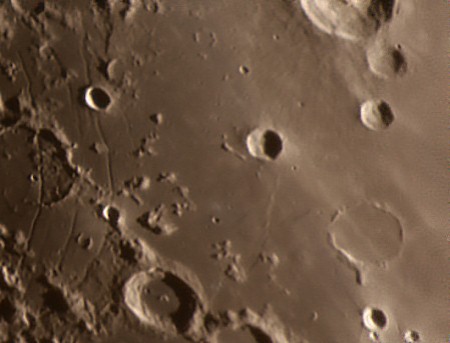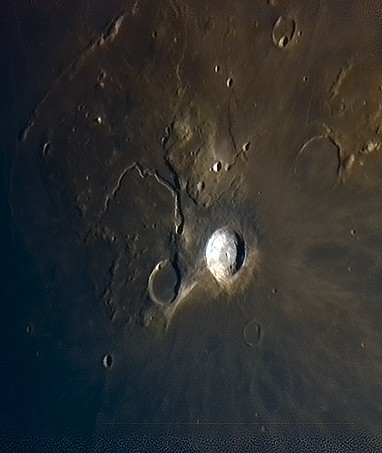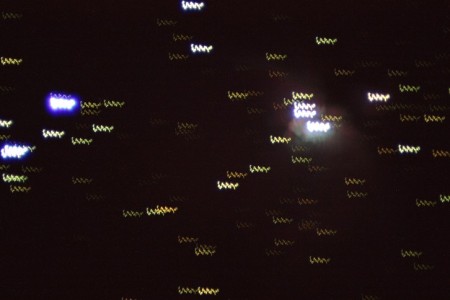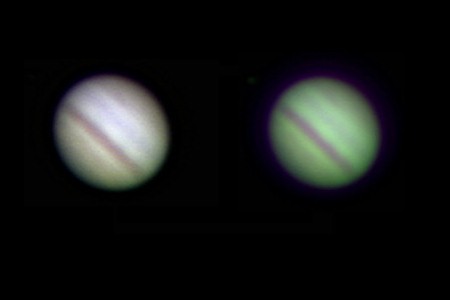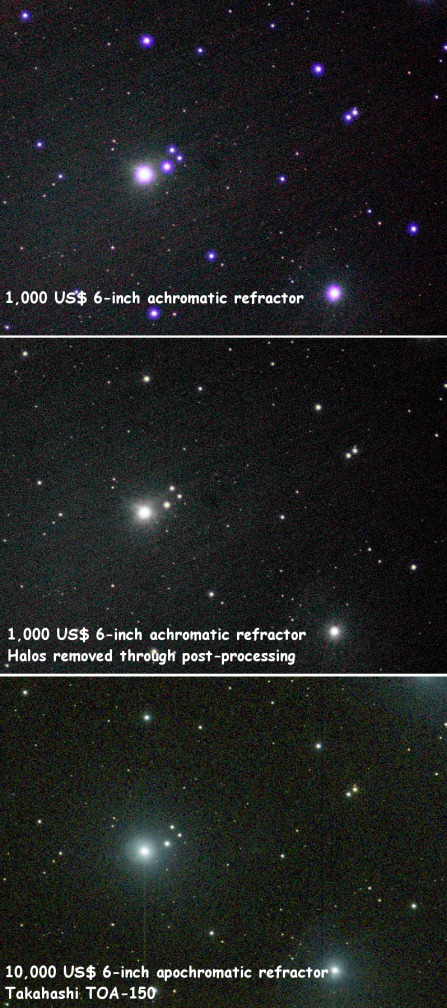Very close to Tringulum galaxy M33 we may spot a bright open cluster towards Perseus constellation. Its name is M34 and here it is a picture I took today through a remote 6 inch apochromatic refractor on New Mexico that shows colorful stars. Enjoy it!
Archive for Astrophotography
M34 Open Cluster at Perseus Constellation
Posted in Astrophotography with tags 6 inches, apochromatic, Astronomy, Astrophotography, color, Fitswork4, M34, Open Cluster, Paint Shop Pro 9, refractor, starts, Telescope on 2013/10/12 by computerphysicslabMoon scratched by the claw of a bear
Posted in Astrophotography with tags Astronomy, Astrophotography, Bullialdus crater, Canon EOS 450D, Manual-Crazy-Tracking, Meade Lightbridge 16", Moon, Newtonian, no tracking, Reflex, Registax, Rimae Hippalus, Telescope on 2011/08/31 by computerphysicslabNear Bullialdus crater (at top-right side of the picture) there is a quite interesting region called Rimae Hippalus. Hippalus crater is the big one (left-center side of the picture). It is a big crater. In this image, shadows in this crater due to a low altitude sunlight creates a visual effect, as if a great creature had stamped his bare footprint in lunar soil. Do you see it?
Bright nebulae at Milky Way core
Posted in Astrophotography with tags Astronomy, Astrophotography, Canon EOS 450D, constellation, Deep sky, Fitswork4, Milky Way, nebula, Rebel XSi, Reflex, Sagittarius, Scorpius, Telescope on 2011/07/04 by computerphysicslabSummer views of Milky Way are spectacular because the galaxy bulge is brighter and broader than its spiral arms visible the rest of the year. Located near Sagittarius and Scorpius constellations, the bright nebulae and dark lanes of the area creates a beautiful contrast in brightness and colors.
This picture is a 4-pane mosaic ensambled with free software Fitswork 4.40. Every pane is a 10 minutes exposition through a 55mm lens attached to a Canon EOS 450d (Rebel XSi) DSLR camera, mounted over a motorized equatorial mount, Sky Watcher EQ6.
A full resolution picture is available at AweSky
Aristarchus crater (Moon) with Meade Lightbridge 16 inch
Posted in Astrophotography with tags Astronomy, Astrophotography, Canon EOS 450D, crater, Manual-Crazy-Tracking, Meade Lightbridge 16", Moon, Newtonian on 2011/04/17 by computerphysicslabAristarchus crater (Moon) with Meade Lightbridge 16 inch:
Aristarchus is a large impact crater on the Moon, is in the northwest of the nearside of the Moon. It is considered the brightest of the large formations on the lunar surface, its albedo is nearly double that of most other geographical spots. The crater is bright enough to be visible to the naked eye and is stunning when viewed through a large telescope. It is also easy to identify when most of the lunar surface is illuminated by reflection of light on Earth.
The crater is located on the southeast edge of the Aristarchus Plateau, an area that contains several high volcanic features, such as wrinkling rimes. This area is known for it have been detected in a significant number of transient lunar phenomena of nature as well as by recent emissions gas radon to be measured by the spacecraft Lunar Prospector.
EQ6 periodic error
Posted in Astrophotography with tags Astronomy, Astrophotography, Canon EOS 450D, Deep sky, DSLR, EQ6, guiding, mount, PEC, periodic error, Rebel XSi, Reflex, Sky Watcher, tracking on 2011/04/06 by computerphysicslabI took a bunch of 30 seconds shots aiming M42 nebula as regular, in order to stack them later. Polar alignment was also regular, using EQ6 polar scope, probably not perfect.
I think M42 is a good target to measure periodic error in RA movement due to its near 0 degrees declination.
In order to show the drift, I stacked the shots without drift correction using a free software called startrails that gets the brightest pixels per shot, obtaining that way the best startrail you can achieve.
To measure the length of the drift, I requested a single shot solved plate from astrometry.net. They provide an exact width in arcminutes of the field. Then, I divide the width field by the width in pixels of my DSLR camera sensor, obtaining the resolution per pixel in arcseconds (a number close to 1 arcsecond/pixel for a 1,200 mm effective focal length telescope).
Then I measure the height of RA drift pattern with my regular post-processing free software, Fitswork4, and multiply that value by the previous resolution.
That is the way I have found that my EQ6 mount drifts around 40 arcseconds in RA movement. Dividing total exposure by the number of cycles (top peak to lower peak) I got the elapsed time needed to fulfill the periodic error: around 6 minutes long.
Moons of Saturn through telescope
Posted in Astrophotography with tags Astronomy, Astrophotography, Camera, CCD, Celestron, DBK, Dione, Iapetus, Moons of Saturn, planet, planetary, Registax, Rhea, ring, satellites, Saturn, shift-and-add, solar system, stacking, Tethys on 2011/03/09 by computerphysicslabTitan, Tethys, Rhea, Dione, Iapetus are five bright moons of Saturn, the ring planet in our Solar system. They can be observed through amateur telescopes with at least 100mm (4 inches) of aperture. The following picture was taken through a 5 inch telescope, a Celestron NexStar 5 SE XLT. It is an image composed of 84 single subframes of 1 second of exposition each one.
It was taken on 2011-03-06 02h10mUT using a DBK 21AU04.AS Imaging Source CCD camera. Planet was recorded in a different exposition through a video stacked (shift and add) using Registax free software.
Check out the JPL simulation matching the picture above.
Mare Crisium and Palus Somni
Posted in Astrophotography with tags Astronomy, Astrophotography, Canon EOS 450D, craterlets, craters, Impact crater, Mare Crisium, Moon, Palus Somni, Proclus, Rebel XSi, solar system, Telescope on 2011/02/28 by computerphysicslabMare Crisium is one of my favorite Moon areas. There is a lot of details inside Crisium, but it is not easy to detect, because it is very fine. High aperture telescopes are needed to spot the small impact craters inside this maria, because its typical lengths are 1 or 2 kilometers wide.
Near Mare Crisium there is another big area called Palus Somni (below), that is visible in this picture made with an amateur telescope. The big and bright crater in the middle is Proclus:
The telescope used is a Celestron Nexstar 5SE and the camera is a Canon EOS 450d (Rebel XSi) DSLR. The picture actually is a mosaic made of two panes.
Fringe color filter – Achromatic refractor
Posted in Astrophotography with tags Astronomy, Astrophotography, filter, Jupiter, Refracting telescope, Telescope on 2010/12/12 by computerphysicslab
- Image via Wikipedia
Fringe color filters are able to cut almost completely the secondary spectrum on images taken through telescopes that yield chromatic aberrations, like an achromatic refractor. Here is an example of the difference between an picture of Jupiter taken through a fringe color filter (left) and a similar picture taken without that filter (right).
Related articles
- Tips on Learning to Use Telescopes (brighthub.com)
- Good Telescopes for Kids (brighthub.com)
North America Nebula
Posted in Astrophotography with tags Astronomy, Astrophotography, Canon EF-S 18-55mm, Canon EOS 450D, Cygnus, Deep sky, Fitswork4, Milky Way, NGC 7000, North America Nebula, Paint Shop Pro on 2010/11/04 by computerphysicslabThis picture of North America Nebula (NGC 7000, a bright nebular region located in the Milky Way area of Cynus) was taken yesterday, 2010-11-03 under good transparency skies, using a 55mm lens and Canon EOS 450d, Rebel XSi and an EQ6 mount doing the unguided tracking. This is just one shot of 1380 seconds of exposition (23 minutes).
Postprocessing done using PSP9 and Fitswork4.
NGC 7000 is an emission nebula in the constellation Cygnus, near Deneb (α Cygni), also called the North American Nebula. The dark central region called the Gulf of Mexico, as in some astronomical plates for many years resembled that region of America.
Nebula NGC 7000 is the largest covering an area equivalent to the full moon, but its low surface brightness does not normally visible to the naked eye (though, in a dark, using a UHC filter can be seen without optical aid) NGC 7000 and the nearby Pelican Nebula (IC 5070) are part of the same interstellar cloud of ionized hydrogen (HII region). The dark area in the center is a very dense region of interstellar material in front of the nebula and which absorbs light of it, giving the group its characteristic shape.
It is not known with precision the distance that separates us from NGC 7000, neither the star responsible for the ionization of hydrogen that results in the emission of light. Supposing Deneb is the star that illuminates the nebula NGC 7000 then the distance to Earth is on the order of 1800 light years.
Apochromatic vs Achromatic Refractor
Posted in Astrophotography with tags aberration, achromatic, apochromatic, Astronomy, Astrophotography, chromatic, compare, equipment, myth, Sky Watcher, takahashi, Telescope, versus on 2010/10/14 by computerphysicslabPeople should think twice before purchasing an apochromatic refractor as opposed to an achromatic telescope. There is a huge difference in price and a small difference in performance according to an experiment I made recently.
In doing astrophotography, people use to spend a lot of money in equipment. It is important not to fall into the elitist apochromatic myth if you want to save some money.
I took a single 30 seconds shot to Pleiades open cluster (M45) using my 6-inch Sky-Watcher achromatic refractor that costs around 1,000 US$. Then I used a 6-inch apochromatic Takahashi TOA-150 that costs around 10,000 US$ to take an equivalent shot on the same field.
Resulting images speak by themselves. Obviously achromatic refractor shows a blue halo around stars, due to chromatic aberration. Nevertheless, a simple post-processing technique can remove the halo, obtaining a similar image to apochromatic’s.
Now, the question is: Is it worth paying the extra 9,000 US$?
Comet 103P/Hartley
Posted in Astrophotography with tags 103P, Astronomy, Astrophotography, Comet, Hartley, Hertley2, Telescope on 2010/10/12 by computerphysicslabComet Hartley 2, officially known as 103P/Hartley 2 is a small comet that orbits the Sun with a period of 6.46 years. It was discovered by astronomer Malcolm Hartley in 1986 using the Schmidt telescope in Siding Spring Observatory (Australia).
It is estimated that its nucleus has a size between 1200 and 1600 meters, according to recent observations of the Spitzer Space Telescope (August 2008): its albedo, very small, is close to 0.028 as it is covered with very dark carbonaceous bodies probably hydrocarbons. The mass is estimated around 3 × 10 ^ 11 kg.
In its approach to the Sun of 2010 is visible in the constellations of Cassiopeia, Perseus and Auriga, but could be visible to the naked eye in mid-October of that year from places with dark skies: it reaches its minimum distance from our planet on October 20th standing at only 0.12 Astronomical Units. A few days later, on October 28th, passes through the perihelion located a little over 157 million miles from our star.
In their approach the year 2010 this image was obtained through a 6-inch refractor telescope.
Its next step takes place on April 2017.
Jupiter 2010 Opposition
Posted in Astrophotography with tags 2010, Astronomy, Astrophotography, Jupiter, Opposition, Telescope on 2010/10/03 by computerphysicslabCurrently, Jupiter is at its minimum distance from Earth, which does not happen since 47 years. While the largest planet in the solar system can always be spotted with the naked eye, this time will look brighter.
The phenomenon is called opposition, and occurs when a planet is located exactly opposite to the Sun in the sky, meaning, the same side of Earth’s orbit about the sun. In such cases, the distance between the two planets is minimal. The oppositions between Earth and Jupiter occur every 13 months.
However, as the orbits of both planets are not perfectly round nor perfectly concentric, these approaches are not always the same. There is a “better” and a “worse” opposition. And the gap between the two planets varies from 591 to 676 millions of kilometers. Consequently, the brightness and apparent size of Jupiter also varies.
The current opposition of Jupiter is excellent, with the planet at nearly 592 million of kilometers from Earth. Equivalent to about 1,500 times the distance to the Moon, but Earth and Jupiter can not get much closer than that. The last time Jupiter was so close to Earth in October 1963 was 47 years ago. And it will not happen again until September 2022.
Digital camera & Binoculars
Posted in Astrophotography with tags afocal, Astrophotography, Binocular, British Standard Whitworth, BSW, Casio Exilim EX-Z80, screw, Vixen 12x80 on 2009/02/27 by computerphysicslabHere is my way to attach the pocket digital camera Casio Exilim EX-Z80 to my binoculars Vixen 12×80. It is necessary to cut a piece of aluminum respecting the format of the binoculars, calculating the correct distance between the hole that grabs the camera and the hole to fix with the tripod and the binoculars. Remember to always use British Standard Whitworth (BSW) screw threads, 1/4 inch, and to drill the holes for this width.
This way it is easy to do afocal astrophotography, and get sharp focus, because the camera remains pointed correctly through one eyepiece of the binoculars.


